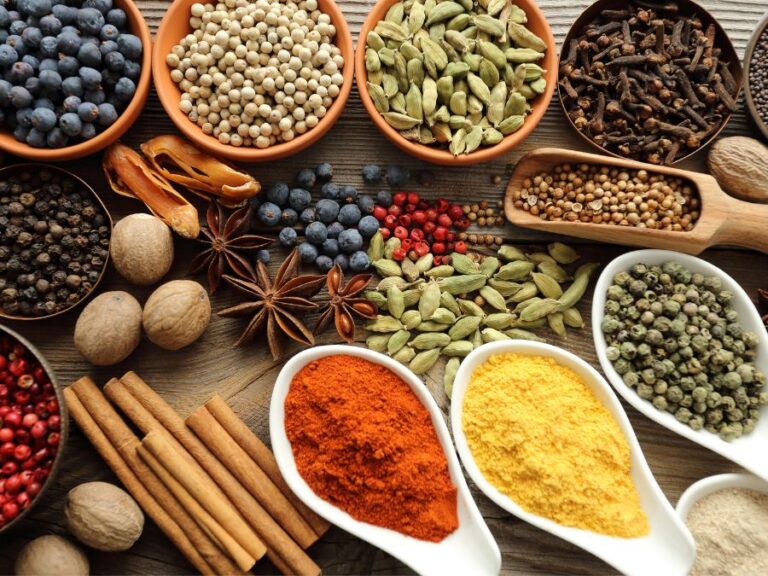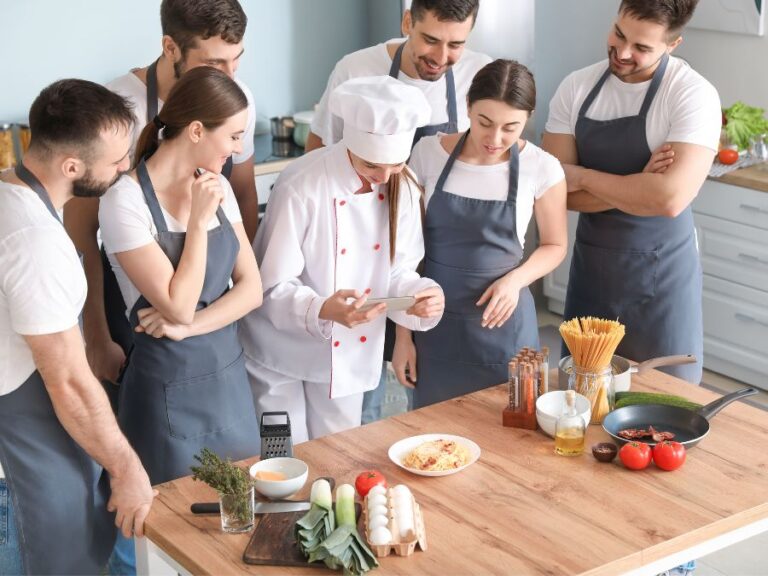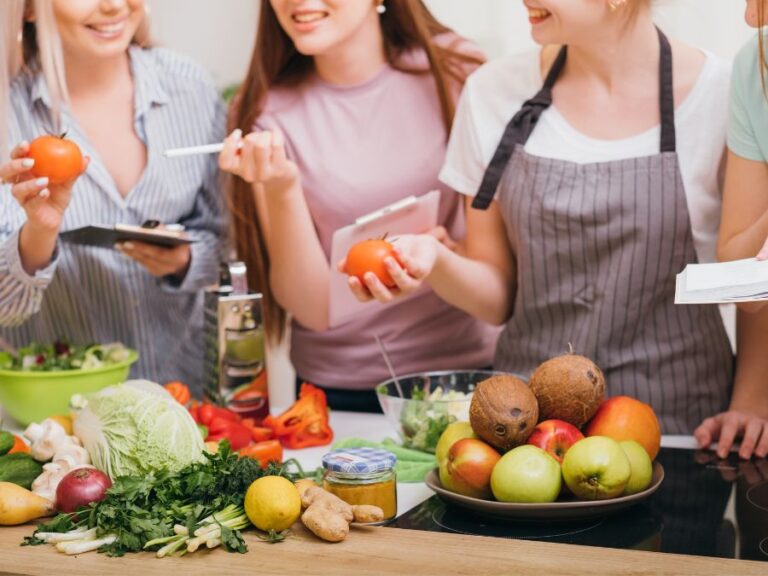Secrets From the Kitchen: Tips and Tricks From Worldly Chefs
Discover the world of culinary artistry with secrets from worldly chefs, where we reveal flavor-enhancing techniques like utilizing fresh herbs strategically and roasting spices for intensified flavors. Master knife skills for efficiency, sharpen knives regularly, and save time with kitchen tricks like batch cooking. Uncover global ingredient insights for unique flavors and learn plating techniques for visual impact. Let’s reveal culinary creativity, perfect pairings, cooking temperatures mastery, and chef’s tips, unraveling a treasure trove of kitchen wisdom to enhance your skills and culinary creations.
Flavor-Enhancing Techniques
As chefs, we often enhance flavors by incorporating fresh herbs and spices at the right moment during cooking. Adding herbs like basil, cilantro, or parsley towards the end of the cooking process can help release their vibrant flavors and colors. Sprinkling in dried spices like cumin, paprika, or turmeric at the beginning allows their aromas to blossom and infuse into the dish. By layering these ingredients strategically, we create depth and complexity in taste that captivates the palate.
Another technique we employ is toasting spices before use. This simple step helps to unleash their essential oils and intensify their flavors. Whether it’s cumin seeds, mustard seeds, or whole peppercorns, a quick toast in a dry pan can make a world of difference. We pay close attention during this process to avoid burning, as it can turn the spices bitter.
Furthermore, we often use citrus zest to brighten up dishes. The outer layer of citrus fruits like lemons, limes, or oranges contains flavorful oils that can elevate a dish with a burst of freshness. By grating the zest into salads, marinades, or desserts, we bring a new dimension to the taste profile.
Knife Skills Mastery
In sharpening our culinary expertise, mastering knife skills is a vital aspect that amplifies our efficiency and precision in the kitchen. Proper knife techniques not only make food preparation quicker but also guarantee uniform cuts for even cooking.
One essential skill is the ’claw grip,’ where the fingertips tuck under and the knuckles guide the blade to prevent accidents and maintain consistency in cuts. Additionally, honing your knives regularly with a honing steel keeps the blades sharp and enhances their longevity, reducing the need for frequent sharpening.
When chopping, using a rocking motion with the knife helps to maintain control and speed. It’s also important to choose the right knife for the task at hand, whether it’s a chef’s knife for general use or a serrated knife for slicing bread without crushing it.
Time-Saving Kitchen Hacks
Let’s explore some smart kitchen shortcuts that can help save valuable time during meal preparation.
One time-saving hack is to prep ingredients in advance. Chopping vegetables, marinating meat, or measuring out spices ahead of time can greatly reduce the cooking process.
Another useful tip is to make the most of kitchen gadgets like food processors, slow cookers, or instant pots. These appliances can help streamline cooking tasks and reduce active cooking time.
Additionally, utilizing leftovers creatively can save time on future meals. For instance, turning last night’s roasted chicken into a quick stir-fry or incorporating leftover vegetables into a frittata can be a time-efficient way to create new dishes.
Batch cooking is another time-saving strategy. Making large portions of meals and freezing individual servings for later can save time on busy days when cooking from scratch isn’t feasible.
Global Ingredient Insights
Exploring diverse culinary traditions can enrich our palate with unique flavors and textures from around the world. When it comes to global ingredients, the possibilities are endless. From the smoky depth of Spanish paprika to the umami richness of Japanese miso, each ingredient adds its own special touch to a dish.
One key to using global ingredients effectively is understanding their role in different cuisines. For example, the floral notes of saffron are essential in Spanish paella, while the earthy tang of tamarind is a staple in many South Asian curries. By learning about the traditional uses of these ingredients, we can incorporate them authentically into our own cooking.
Exploring global ingredients also allows us to experiment and create unique flavor combinations. Mixing Middle Eastern sumac into a citrusy salad or adding Korean gochujang to a marinade can elevate familiar dishes into something truly extraordinary. Embracing global ingredients opens up a world of culinary possibilities, inviting us to commence on a flavorful journey of discovery.
Plating Like a Pro
Mastering the art of plating elevates a dish from mere food to a visual masterpiece. Presentation is key in the culinary world, and the way a dish is plated can greatly impact the overall dining experience.
When plating like a pro, attention to detail is essential. Start by considering the size and shape of the plate – different dishes may benefit from specific styles of plates. Utilize negative space to create balance and highlight the main components of the dish. Garnishes shouldn’t only add flavor but also complement the colors and textures of the food.
Remember, less is often more when it comes to plating. A cluttered plate can be overwhelming, so aim for simplicity and elegance. Experiment with different plating techniques, such as layering, stacking, or using edible flowers for a pop of color.
With practice and a keen eye, you can transform any dish into a work of art on a plate.
Culinary Creativity Unleashed
Spark your culinary creativity by exploring unconventional flavor combinations and cutting-edge cooking methods.
In the world of cooking, pushing boundaries and experimenting with new ingredients can lead to exciting and innovative dishes. One way to ignite your creativity is by combining unexpected flavors like adding a hint of spice to a sweet dessert or incorporating savory elements into traditionally sweet dishes. Don’t be afraid to mix and match ingredients that might seem unconventional at first – you never know what delicious creations you might come up with!
Additionally, exploring cutting-edge cooking methods can take your dishes to the next level. Techniques like sous vide cooking, molecular gastronomy, or using innovative kitchen gadgets can open up a world of possibilities for creating unique and visually stunning plates. Embrace the opportunity to learn new skills and experiment with different techniques to elevate your culinary creations.
Secrets of Perfect Pairings
Let’s uncover the art of creating perfect flavor pairings to elevate your culinary creations to new heights. Pairing flavors is like composing music; each ingredient plays an essential role in creating a harmonious dish. One secret to achieving perfect pairings is balancing tastes – sweet with savory, salty with tangy. This balance creates a symphony of flavors that dance on your taste buds.
Consider the intensity of flavors when pairing ingredients. Match bold flavors with subtle ones to prevent overwhelming the palate. For example, a rich and creamy risotto pairs beautifully with a light, acidic tomato salad. Texture also plays a significant role in pairing. Combining crunchy elements with softer ones adds dimension to your dish.
Don’t be afraid to experiment with unconventional pairings. Sometimes the most unexpected combinations create the most delightful flavors. The key is to trust your palate and be open to trying new combinations. By mastering the art of perfect pairings, you can take your culinary creations to a whole new level of deliciousness.
Mastering Cooking Temperatures
Understanding the importance of precise cooking temperatures is crucial for achieving perfectly cooked dishes every time. Whether searing a steak, baking a delicate soufflé, or simmering a savory stew, knowing the right temperature can make all the difference in the outcome of your culinary creation.
One key tip from chefs worldwide is to invest in a dependable instant-read thermometer. This tool guarantees accuracy and takes the guesswork out of determining whether your meat is medium-rare or well-done.
When it comes to sautéing, heating your pan over medium heat before adding oil prevents food from sticking and allows for even cooking. For deep-frying, maintaining the oil temperature between 350-375°F (177-190°C) guarantees crispy results without the greasiness of oil-soaked food.
Oven-roasting at high temperatures caramelizes the exterior of meats and vegetables, creating a flavorful crust while keeping the insides juicy. Mastering cooking temperatures is a fundamental skill that elevates your dishes from good to exceptional.
Chefs Tips for Home Cooks
Chefs recommend integrating fundamental knife skills into your cooking routine to enhance efficiency and safety in the kitchen. By mastering techniques like proper grip, claw hand, and the rocking motion, you can chop ingredients quickly and evenly, reducing the risk of accidents.
Another suggestion from chefs is to always read a recipe in its entirety before starting to cook. This guarantees you have all the necessary ingredients and equipment ready, avoiding any last-minute scrambling.
Additionally, tasting as you cook is an essential step that chefs swear by. Adjusting seasoning and flavors throughout the cooking process ensures a well-balanced dish in the end.
Home cooks can also benefit from keeping a clean and organized workspace. This not only speeds up cooking but also makes the entire experience more enjoyable.





